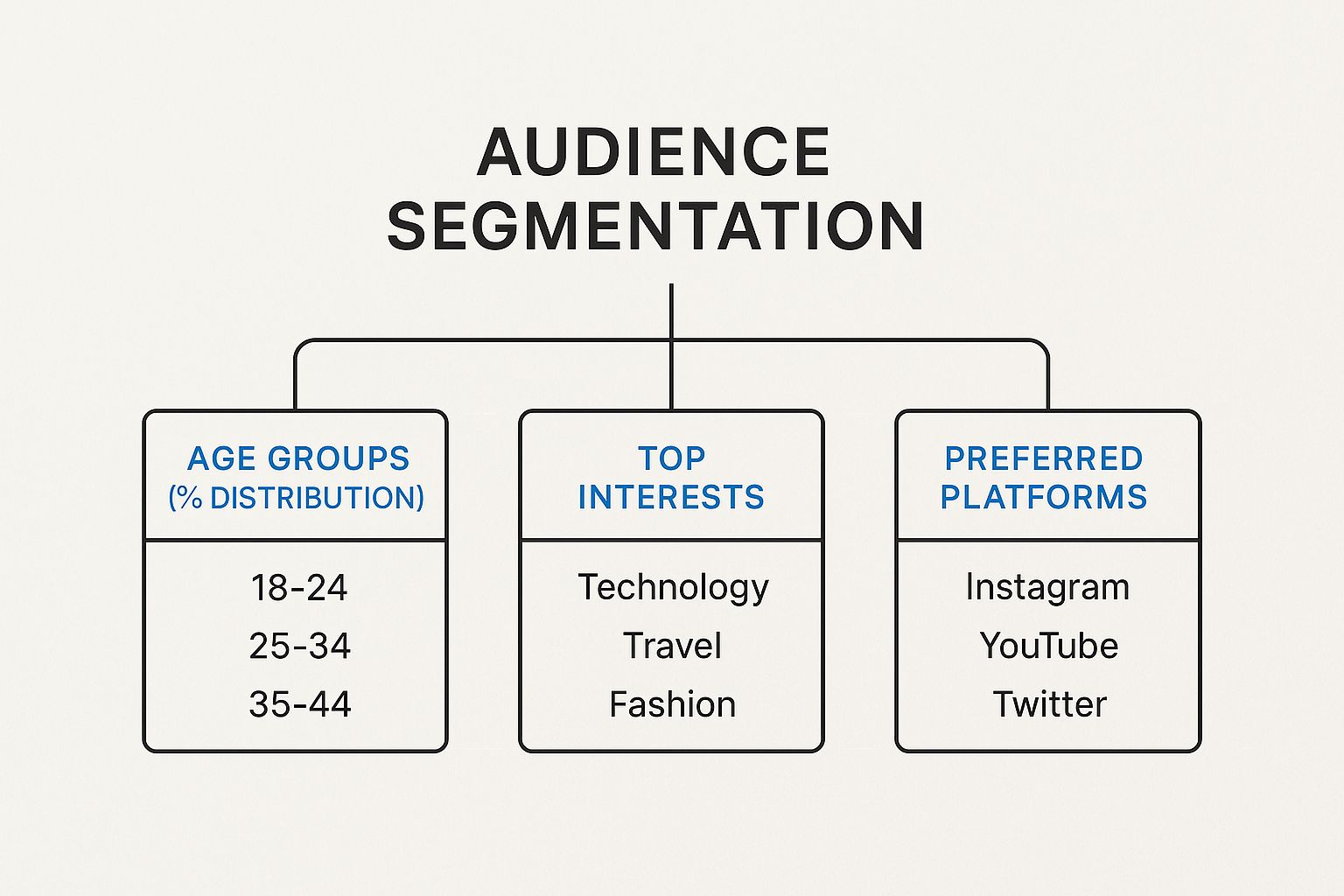

When you hear "social media marketing services," what does that actually mean for a small business?
Think of it this way: you could probably cook a decent meal for your family. But if you were opening a restaurant, you'd hire a professional chef. They bring strategy, consistency, and a level of polish that turns a simple dish into a memorable experience. That's what social media marketing services do for your business.
They're the expert team you bring in to manage your brand's presence online, handling everything from strategy and content to advertising and talking with customers. This lets you get back to running your business, knowing a critical piece of your marketing is handled by pros.
Let's cut through the buzzwords. Partnering with a social media team isn't just about getting pretty pictures on your feed; it's about building a predictable system for growth. For a small business, this isn't a luxury anymore—it's how you compete.
The numbers don't lie. Over 75% of small and medium-sized businesses (SMBs) say social media directly helps their bottom line. With 82% of SMBs already on platforms like Facebook, the pressure is on to produce high-quality, fresh content constantly. If you want to dive deeper, these SMB social media marketing statistics paint a clear picture of the landscape.
To make sense of it all, I find it helpful to break the services down into four core pillars. Each one plays a specific role in turning your social media accounts into real business assets.
Most professional social media marketing services are built on these four key components. Think of them as the legs of a sturdy table—if one is missing, the whole thing gets wobbly.
To give you a quick snapshot, here’s how these pieces fit together.
Service Component
Primary Goal for a Small Business
Strategy Development
To create a clear roadmap with measurable goals, like lead generation or brand awareness.
Content Creation & Curation
To build a consistent brand voice and keep your audience engaged with valuable posts.
Community Management
To turn followers into a loyal community by interacting with them directly and building trust.
Paid Ads & Analytics
To reach new customers, drive conversions, and provide clear proof of what's working.
This table gives you a simple way to see how each service directly contributes to your business's success.
When you outsource these tasks, you're not just buying posts. You're investing in a complete system designed to attract, engage, and convert customers.
Ultimately, it’s about freeing up countless hours for you while making sure your online presence is professional, consistent, and—most importantly—effective.

Handing over your social media accounts can feel like a huge leap of faith. I get it. Beyond just getting more posts up, what can you actually expect? The real answer goes way past surface-level stuff like likes and shares.
Think of it like hiring a general contractor versus a DIY renovation. You could try to build that extension yourself, but a pro shows up with specialized tools, years of seeing what works (and what doesn't), and a strategic blueprint. They save you from costly mistakes and deliver a predictable, quality result.
A professional social media team does the same thing. They don't just "do social media"—they install a system for growth, freeing you up to run your business.
As a small business owner, time is the one thing you can't make more of. Let's be honest, proper social media management is a full-time job. It’s strategy, content creation, scheduling, engaging with comments, and digging through analytics.
When you try to juggle all that yourself, it usually means sporadic posts and inconsistent results.
Hiring a service buys those hours back immediately. Instead of spending your evenings wrestling with Canva or trying to decipher the latest algorithm change, you can focus on what you do best. That might be serving customers, managing inventory, or developing new products. This is often the first and biggest return on your investment.
Great social media isn't just about having good ideas; it's about executing them with the right tools and deep industry knowledge. Agencies and freelancers live and breathe this stuff. They know the subtle differences between each platform's algorithm and have access to premium scheduling and analytics software that would be way too expensive for a single small business.
This expertise gives you a few key advantages:
A professional service transforms your social media from a hopeful guess into a calculated strategy. They replace random acts of marketing with a consistent, data-informed system designed to get you specific, measurable results.
Consistency is everything when it comes to building trust. When your social media is managed professionally, your messaging, tone, and look stay consistent across every platform. That reliability builds a much stronger connection with your audience, helping turn casual followers into loyal customers.
A dedicated team also makes your growth predictable. They implement strategies to build your audience, run targeted ad campaigns to reach new customers, and actively engage with your community to keep them loyal.
This is how your social channels go from being a passive billboard to an active, lead-generating engine that reliably contributes to your bottom line. That consistent effort is what separates a stagnant profile from a thriving online community.
Opening a proposal for social media marketing can feel like trying to read a foreign language. You're hit with terms like "content pillars," "community engagement," and "ad optimization." This section is your decoder ring—we're breaking down exactly what you should find inside a quality service package so you know what you're paying for.
Think of it like buying a car. The sticker price is one thing, but you need to know what’s under the hood—the engine, the safety features, the tech. A solid social media package is the same; it’s made up of several core parts that all work together to move your business forward.
Let's look at what those parts are.
Before a single post goes live, a real pro starts with a plan. This isn’t a vague promise to "get you more followers." It's a detailed blueprint, built on research, that maps out who your ideal customer is and how to actually reach them.
This first phase is all about homework. It involves:
This infographic gives you a simplified peek at how an agency might break down an audience after doing their initial research.

Getting this part right means the agency can pick the right platforms and craft messages that genuinely connect with the people you want to turn into customers.
This is the part of the service you'll see every day. It's the posts, videos, and stories that show up on your feeds and represent your brand. But a quality service goes way deeper than just posting a few times a week.
A great content plan is a mix of art and science. It combines creative storytelling with data-backed decisions about what to post, where to post it, and when to post it for maximum impact.
A professional package should always include:
Social media is a two-way street. Any service that just broadcasts your messages is missing half the point. Real growth comes from building an actual community around your brand.
This means your provider should be actively:
This hands-on management is what turns passive followers into loyal fans who tell their friends about you.
Let's be honest: getting seen on social media without paying is tougher than ever. That's why paid advertising is a key part of most successful strategies today. This service is a lot more than just hitting the "boost post" button.
A dedicated ad manager will handle:
Finally, a good provider will never leave you guessing. Regular, easy-to-understand reports are non-negotiable. This is how you see what's working and prove the money you're spending is worth it.
Your package should include monthly or bi-weekly reports that clearly lay out:
This transparency ensures you always know what’s being done and how it's helping your business hit its targets.
Not all packages are created equal. As you shop around, you'll see different tiers—often labeled Basic, Standard, and Premium. The table below gives you a general idea of what to expect at each level, helping you match a service package to your budget and goals.
FeatureBasic PackageStandard PackagePremium PackageStrategy & PlanningInitial setup & basic content planDetailed audience & competitor analysisComprehensive strategy, quarterly reviews & ongoing optimizationPlatforms Managed1-2 platforms2-3 platforms3+ platforms, including emerging channelsContent Creation2-3 posts/week, stock imagery4-5 posts/week, custom graphics7+ posts/week, custom graphics, video, & professional photographyCommunity Management5 days/week, business hours7 days/week, extended hours24/7 monitoring & proactive engagementPaid Ad ManagementPost boosting onlyDedicated ad campaigns, <$1,000/mo spendAdvanced campaigns, >$1,000/mo spend, A/B testing & optimizationReportingBasic monthly metrics reportDetailed monthly report with analysisIn-depth bi-weekly reports, custom dashboard & strategy callsTypical Monthly Cost$500 - $1,500$1,500 - $4,000$4,000+
Keep in mind that these are just general guidelines. The key is to find a package that provides the specific services you need to grow, without paying for extras that don't make sense for your business right now.

Alright, let’s talk money. Figuring out how much to sink into social media marketing services for small businesses can feel like trying to hit a moving target. To make a smart call, you first have to get a handle on the different ways agencies and freelancers price their work.
Each model has its own pros and cons. The right one for you comes down to your specific needs, your goals, and frankly, how much financial predictability you need to sleep at night.
Once you start asking for quotes, you’ll run into three main ways providers structure their fees. Getting the mechanics of each one will help you compare apples to apples and find a partner that fits your budget.
The right pricing model isn’t just about finding the “cheapest” option. It’s about finding the structure that delivers the most value for the consistent effort required to hit your business goals.
Once you understand the pricing models, the next step is building a budget that actually makes sense for your business. A classic mistake is only planning for the agency's management fee. A complete, effective social media budget has two distinct parts you need to balance.
Your total investment should be split between two buckets:
Skipping the ad spend is like buying a Ferrari but refusing to put gas in it. The global spend on social media ads is projected to hit $276.7 billion in 2025, and for good reason—it flat-out works. To even be in the game, you have to invest in both the expert management and the ad budget that lets them do their job. You can dig into more spending data on Sprout Social's insights page.
As a general starting point, a small business can expect to spend anywhere from $500 to $4,000+ per month on service fees, depending on what's included. A healthy starting ad spend is usually another $500 to $1,500 per month. By planning for both right out of the gate, you give your social media efforts a much, much higher chance of actually delivering a positive return on your investment.

Picking the right company for your social media marketing services for small businesses is easily the most critical decision you'll make here. This isn't just about hiring a vendor; it's about finding a genuine partner who becomes an extension of your team. The right choice can feel like pouring gasoline on your growth, while the wrong one just burns through time and cash.
Think of it like choosing a co-pilot for a cross-country flight. You need someone who knows the route, has a clear plan, and can communicate when you hit turbulence. This section is your pre-flight checklist for finding that perfect partner.
Before you even think about Googling an agency, you need to look inward. You can't find the right fit if you don't know what you need them to do. A fuzzy goal like "I want more followers" just isn't going to cut it.
You have to get specific. What business problem are you actually trying to solve?
Jotting these down gives you a scorecard to measure every potential partner against.
Once you've got a short list of agencies or freelancers, it's time to start digging. This is where you separate the people who just talk a good game from the ones who actually deliver. You're looking for proof that they can back up their promises and that their style works with yours.
Start with their past work. A solid portfolio is more than just a collection of pretty posts; it should show you real, tangible results. Hunt for case studies in your industry or from businesses that were struggling with the same problems you are. A great agency will have no problem showing you exactly how they helped another client grow their sales or boost community engagement.
A flashy portfolio with big numbers from a totally unrelated industry is way less valuable than one solid case study proving they get the challenges and opportunities in your market.
Next, get them on the phone. The interview is your chance to really feel out their expertise and see how they communicate. To make sure you're asking the right things, we've put together a full guide on the questions to ask a marketing agency. It covers everything from strategy and reporting to who you'll actually be talking to every day.
During your calls, focus on questions that force them to talk about their process and strategic thinking. Generic, canned answers are a huge red flag. You want a partner who has obviously put some real thought into your business.
Here are a few questions you absolutely have to ask:
Choosing your social media partner is a major investment in your business's future. If you take the time to define your needs, properly vet their work, and ask sharp questions, you’ll find a team that doesn't just manage your accounts—they'll help drive real, measurable growth.
Once your social media foundation is solid, it's time to find a real competitive edge. The best social media marketing services for small businesses don't just stop at daily posts and ads. They push into advanced tactics that turn your social channels into powerful revenue drivers.
Two of the most effective strategies out there right now are influencer marketing and social commerce. These aren't just buzzwords for giant corporations anymore. They're accessible, affordable, and highly profitable approaches that can set your small business miles apart from the competition. Let's break down how they actually work.
Influencer marketing probably sounds expensive, but the real opportunity for small businesses is with micro-influencers. These are creators with smaller, highly-engaged audiences, typically between 10,000 to 100,000 followers. They've built incredible trust within a specific niche.
Think of them less like celebrities and more like a trusted friend giving a recommendation.
When a local foodie blogger with 15,000 devoted followers raves about your cafe, that endorsement feels personal and authentic. It cuts through the noise of traditional advertising because it comes from a source the audience already knows and trusts. That authenticity is what drives incredible results.
For small businesses, influencer marketing delivers an average return on investment of $5.78 for every $1 spent. This is largely because 61% of consumers trust influencer endorsements more than slick, corporate ads.
Micro-influencers are especially potent, generating engagement rates on Instagram that are more than triple those of the big-name macro-influencers. This makes them a cost-effective and powerful choice for small businesses looking to make an impact. You can explore more of these powerful influencer marketing statistics to see how they might apply to your own strategy. A skilled service provider can find, vet, and manage these partnerships, making sure you connect with the right voices to represent your brand.
The second game-changing strategy is social commerce. This is all about transforming your social media profiles from simple marketing channels into seamless, direct sales platforms. Platforms like Instagram and Facebook have built-in "Shops" features that let customers browse products and make a purchase without ever leaving the app.
Imagine this: a customer sees a post featuring your new handmade leather wallet. Instead of having to click a link in your bio, navigate your website, and hunt for the product, they can just tap the "View Shop" button on your profile, add the wallet to their cart, and check out in a few clicks.
This removes all the friction from the buying process, which can dramatically increase your conversion rates. Getting this set up involves a few key steps:
By integrating these tactics, you meet customers exactly where they are and make it incredibly easy for them to buy from you. Combined with other digital marketing strategies explained in our guides, social commerce can become a significant and predictable source of revenue for your business.
Investing in professional social media services is a big step, and it's smart to have questions. This last section gives you straight answers to the things most business owners worry about before they sign on the dotted line. The goal is to help you feel confident you're making the right call.
This is always the first question, and the honest answer is: it takes some patience. You might see some quick wins, like more comments and shares, within the first month. But the real business results—the kind you can take to the bank, like consistent leads and sales—typically take three to six months to show up.
Think of it like getting a garden going. The first few months are all about prepping the soil (that’s your strategy), planting the right seeds (testing content), and watering every day (engaging with your community). Real growth only happens after that groundwork is done. The agency is building trust and a loyal audience for your brand before you can expect a predictable harvest.
Of course you can, but it’s a direct trade-off: you either spend money or you spend your time. Handling social media in-house saves you the service fee, but it eats up a massive amount of your time. Honestly, getting good at strategy, creating content, managing ads, and reading the analytics is a full-time job on its own.
A professional service brings expertise, proven systems, and specialized tools to the table from day one. The real question to ask yourself is this: could the hours you’d pour into social media generate more money for your business if you spent them on sales, operations, or talking to customers instead?
"Hiring a service isn't admitting you can't do it yourself; it's a strategic decision to invest your time where it delivers the highest return for your business."
Choosing between an agency and a freelancer really comes down to what you need and what your budget looks like.
An easy way to think about it is that an agency is like a general contractor for your marketing, handling everything under one roof. A freelancer is like hiring a master plumber for one specific job.
Success is not about likes and followers. The only metrics that count are the ones tied directly to your business goals. Any decent provider will help you figure out the Key Performance Indicators (KPIs) that actually matter.
Here’s what to focus on:
A good partner won't just send you a wall of data; they'll deliver simple, easy-to-read reports that show you exactly how these specific numbers are moving.
Ready to stop guessing and start growing? Goliath Marketing builds data-driven social media strategies that deliver real, measurable results for your business. Let's talk about getting you more leads and booked jobs. Learn more about our approach at https://goliathmarketing.io.